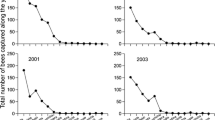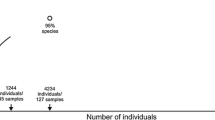Abstract
This study provides information on the number of orchid bees based on a long-term monitoring study in an antropized savanna region in Southeastern Brazil. Sampling was carried out using chemical lures, and 77 samples were monthly collected to assess the number of individuals as well as the annual and seasonal species fluctuation. The number of species varied significantly among years but not among months, and there was a positive correlation between the number of species and the number of individuals in each sample. Monthly number counts revealed a seasonal pattern for Eulaema nigrita Lepeletier and Exaerete smaragdina Perty, which were more numerous during humid months but peaked in December, January, and February. Different species of Euglossa presented a significant variation in number among years, but not among months, with no pattern along the years. The community and the populations studied were less stable when compared to those of well-preserved habitats of equatorial forests. The El Niño phenomenon of 1997/98 did not result in negative effects in the populations studied; on the contrary, there was a peak in the number of E. nigrita. The amplitude in the yearly variation of the male orchid bee population reflects the evolutionary history of species living in unpredictable seasonal weather that led to the development of particular adaptive traits designed to deal with environmental uncertainties. This study suggests that the plasticity of the life cycle may explain population stability and provide greater resilience to severe climate change events in the future.


Similar content being viewed by others
References
Ackerman JD (1983) Diversity and sazonality of male euglossine bees (Hymenoptera: Apidae) in Central Panamá. Ecology 64:274–283
Ackerman JD (1989) Geographic and seasonal variation in fragrance choices and preferences of male euglossine bees. Biotropica 21:340–347
Ackerman JD, Roubik DW (2012) Can extinction risk help explain plant-pollinator specificity among euglossine bee pollinated plants? Oikos 121:1821–1827
Aguiar WM, Gaglianone MC (2008) Comunidade de abelhas Euglossina (Hymenoptera: Apidae) em remanescentes de Mata Estacional Semidecidual sobre Tabuleiro no Estado do Rio de Janeiro. Neotrop Entomol 37:118–125
Augusto SC, Garófalo CA (2009) Bionomics and sociological aspects of Euglossa fimbriata (Apidae, Euglossini). Genet Mol Res 8:525–538
Bennett FD (1972) Baited McPhail fruitfly traps to collect euglossine bees. N Y Entomol Soc LXXX:137–145
Bezerra CP, Martins CF (2001) Diversidade de Euglossinae (Hymenoptera, Apidae) em dois fragmentos de Mata Atlântica localizados na região urbana de João Pessoa, Paraíba, Brasil. Rev Bras Zool 18:823–825
Cavassan O, Silva PG, Seniciato TO (2006) Ensino de Ciências, a biodiversidade e o cerrado. In: Araújo ESNN, Caluzi JJ, Caldeira AC (Org.) Divulgação científica e ensino de Ciências, estudos e experiências. Escrituras, São Paulo, p 190–219
Cornelissen T (2011) Climate change and its effects on terrestrial insects and herbivory patterns. Neotrop Entomol 40:155–163
Cortopassi-Laurino M, Knoll FRN, Imperatriz-Fonseca VL (2003) Nicho trófico e abundância de Bombus morio e Bombus atratus em diferentes biomas brasileiros. In: Melo GAR, Santos IA (eds) Apoidea Neotropica: homenagem aos 90 anos de Jesus Santiago Moure. UNESC, Criciuma, pp 285–295
Dressler RL (1982) Biology of the orchid bees (Euglossini). An Rev Ecol Syst 13:373–394
Forrest JRK (2014) Plant-pollinator interactions and phenological change: what can we learn about climate impacts from experiments and observations? Oikos 124:4–13
Garófalo CA, Camillo E, Augusto SC, Jesus BMV, Serrano JC (1998) Nest structure and communal nesting in Euglossa (Glossura) annectans Dressler (Hymenoptera, Apidae, Euglossini). Rev Bras Zool 15:589–596
Holmgren M, Scheffer M, Ezcurra E, Gutiérrez JR, Mohren GMJ (2001) El Niño effects on the dynamics of terrestrial ecosystems. Trends Ecol Conserv 16:89–94
Inoue T, Nakamura K, Salmah S (1993) Population dynamics in unpredictably-changing tropical environments. J Biosci 18:425–455
Jansen DH, de Vries PG, Higgins ML, Kimsey LS (1982) Seasonal and site variation in Costa Rica euglossine bees at chemical baits in lowland deciduous and evergreen forests. Ecology 63:66–74
Jiguet F, Brotons L, Devictor V (2011) Community responses to extreme climatic conditions. Curr Zool 57:406–413
Kimsey LS (1979) An illustrated key to the genus Exaerete with descriptions of male genitalia and biology. J Kansas Entomol Soc 52:735–746
Knoll FRN, Penatti NC (2012) Habitat fragmentation effects on the orchid bee communities in remnant forest of Southeastern Brazil. Neotrop Entomol 41:355–365
Memmott J, Graze PG, Waser NM, Price MV (2007) Global warning and the disruption of plant-pollinator interactions. Ecol Lett 10:1–8
Minuzzi RB, Sediyama GC, Costa JMN, Vianello RL (2006) Influência do fenômeno climático El Niño no período chuvoso da região Sudeste do Brasil. Geogr 15:5–19
Moure JS (2007) Moure’s bee catalogue. http://moure.cria.org.br/index. Accessed 22 March 2015
Nemésio A (2012) Methodological concerns and challenges in ecological studies with orchid bees (Hymenoptera: Apidae: Euglossina). Biosci J 28:118–135
Nemésio A, Silveira FA (2006) Edge effects on the orchid-bee fauna (Hymenoptera: Apidae) at a large remnant of Atlantic rain forest in southeastern Brazil). Neotrop Entomol 35:313–323
Oliveira ML (1999) Sazonalidade e horário de atividade de abelhas Euglossinae (Hymenoptera, Apidae), em florestas contínuas de terra firme na Amazonia. Rev Bras Zool 16:83–90
Parmesan C (2006) Ecological and evolucionary responses to recent climate change. Annu Rev Ecol Syst 37:637–669
Pau S, Wolkocich EM, Cook BI, Davies TJ, Kraft NJB, Bolmgren K, Betancourt JL, Cleland EE (2011) Predicting phenology by integrating ecology, evolution and climate science. Glob Chang Biol 17(12):3633–3643
Pearson DL, Dresller RL (1985) Two-year study of male orchid bee (Hymenoptera: Apidae: Euglossini) attraction to chemical baits in lowlands South-eastern Peru. J Trop Ecol 1:37–54
Pereira-Martins SR, Kerr WE (1991) Biologia de Eulaema nigrita. 3. Inferencias evolutivas. Pap. Avulsos de Zool. (Sao Paulo) 37:245–250
Peruquetti RC (2003) Variação do tamanho corporal de machos de Eulaema nigrita Lepeletier (Hymenoptera, Apidae, Euglossini). Resposta materna à flutuação de recursos? Rev Bras Zool 20:207–212
Peruquetti RC, Campos LAO, Coelho CDP, Arantes CVM, Lisboa LCO (1999) Abelhas Euglossini (Apidae) de áreas de Mata Atlântica: abundância, riqueza e aspectos biológicos. Rev Bras Zool 16:101–118
Rebêlo JMM, Cabral AJM (1997) Abelhas Euglossinae de Barreirinhas, zona do litoral da baixada oriental maranhense. Acta Amazon 27:145–152
Rebêlo JMM, Garófalo CA (1991) Diversidade e sazonalidade de machos de Euglossini (Hymenoptera, Apidae) e preferências por iscas-odores em um fragmento de floresta, no sudeste do Brasil. Rev Bras Biol 51:787–799
Rebêlo JMM, Garófalo CA (1997) Comunidades de machos de Euglossini (Hymenoptera: Apidae) em Matas Semidecíduas do nordeste do estado de São Paulo. An Soc Entomol Bras 26:243–255
Reddy PVR, Verghese A, Rajan VV (2012) Potential impact of climate change on honeybees (Apis spp.) and their pollination services. Pestic Manag Hortic Ecosyst 18:121–127
Rocha-Filho LC, Garófalo CA (2013) Community ecology of euglossine bees in the coastal Atllantic forest of São Paulo State, Brazil. J Insect Sci 13:23
Rohr JR, Mahan CG, Kim KC (2006) Developing a monitoring program for invertebrates: guidelines and a case study. Conserv Biol 21:422–433
Roubik DW (1989) Ecology and natural history of tropical bees. Cambridge University Press, New York, p 526
Roubik DW (2001) Ups and downs in pollinator populations: when is there a decline? Conserv Ecol 5:2
Roubik DW, Ackerman JD (1987) Long-term ecology of euglossine orchid-bees (Apidae: Euglossini) in Panama. Oecologia 73:321–333
Rubin P, Nascimento HEM, Morellato LPC (2010) Variações interanuais na fenologia de uma comunidade arbórea de floresta semidecídua no sudeste do Brasil. Acta Bot Bras 24:756–764
Sakagami SF, Laroca S, Moure JS (1967) Wild bee biocenotics in São José dos Pinhais (Pr), South Brazil. Preliminary Report. J Fac Sci Hokkaido Univ Ser Zool 18:57–1
Sant'Anna Neto (1999) Avaliação das mudanças no regime das chuvas do Estado de São Paulo durante um século (1988 - 1993). Acta Sci 21:915–921
Scaven VL, Rafferty NE (2013) Physiological effects on climate warning on plants and insect pollinators and potencial consequences for their interactions. Curr Zool 59:418–426
Silva ACRA, Nascimento FS (2012) Multifemale nests and social behavior in Euglossa melanotricha (Hymenoptera, Apidae, Euglossini). J Hymenopt Res 26:1–16
Silva IA, Silva DM, Carvalho GH, Batalha MA (2011) Reproductive phenology of Brazilian savannas and riparian forests: environmental and phylogenetic issues. Ann For Sci. doi:10.1007/s13595-011-0071-5
Sofia SH, Santos AM, Silva CRM (2004) Euglossine bees (Hymenoptera, Apidae) in a remnant of Atlantic Forest in Paraná state, Brazil. Iheringia 94:217–222
Storck-Tonon D, Morato EF, Oliveira ML (2009) Fauna de Euglossina (Hymenoptera: Apidae) da Amazônia sul-ocidental, Acre, Brasil. Acta Amazon 39:693–706
Williams NM, Minckley RL, Silveira FA (2001) Variation in native bee faunas and its implications for detecting community changes. Conserv Ecol 5:7
Wittman D, Radtke R, Hoffmann M, Blochtein B (1989) Sazonality and seasonal changes in preferences for scent baits in Eufriesea violacea in Rio Grande do Sul, Brazil (Hymenoptera: Apidae: Euglossini). Entomol Gen 14:217–221
Wolda H (1983) “Long-term” stability of tropical insect populations. Res Popul Ecol 25:112–126
Wolda H (1992) Trends in abundance of tropical forest insects. Oecologia 89:47–52
Wolda H, Roubik DW (1986) Nocturnal bee abundance and seasonal bee activity in a Panamanian forest. Ecology 67:426–433
Zar JH (1999) Biostatistical analysis. Prentice-Hall, New Jersey, p 663
Acknowledgments
I would like to thank Roberto Marono (biologist and laboratory technician) for his assistance with field and laboratory work, and Dr. Luzia Aparecida Trinca for her assistance with the statistical analysis. I also thank the Instituto de Pesquisas Meteorológicas—(IPMet) of the Universidade Estadual Paulista “Júlio de Mesquita Filho”—UNESP Bauru campus for the meteorological data.
Author information
Authors and Affiliations
Corresponding author
Additional information
Edited by Wesley AC Godoy – ESALQ/USP
Electronic supplementary material
Below is the link to the electronic supplementary material.
ESM 1
(XLS 61 kb)
Rights and permissions
About this article
Cite this article
Knoll, F.R.N. Variation in the Abundance of Neotropical Bees in an Unpredictable Seasonal Environment. Neotrop Entomol 45, 129–138 (2016). https://doi.org/10.1007/s13744-015-0347-9
Received:
Accepted:
Published:
Issue Date:
DOI: https://doi.org/10.1007/s13744-015-0347-9




